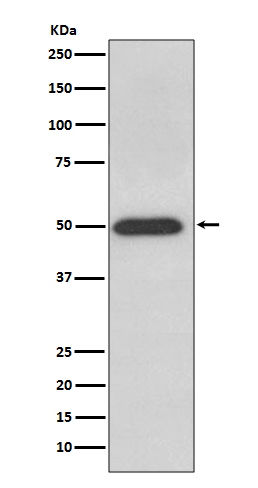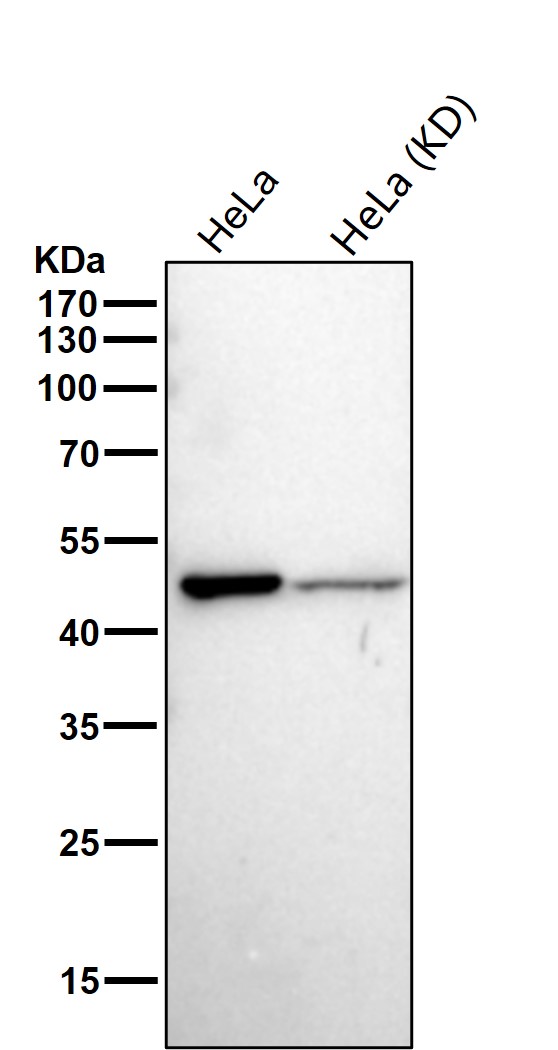

| WB | 咨询技术 | Human,Mouse,Rat |
| IF | 咨询技术 | Human,Mouse,Rat |
| IHC | 1/30-1/150 | Human,Mouse,Rat |
| ICC | 技术咨询 | Human,Mouse,Rat |
| FCM | 咨询技术 | Human,Mouse,Rat |
| Elisa | 1/5000-1/10000 | Human,Mouse,Rat |
| Aliases | ATP 5B; ATP synthase subunit beta mitochondrial; ATPB; ATPMB; ATPSB;;ATP5F1B |
| WB Predicted band size | Calculated MW: 57 kDa ; Observed MW: 50 kDa |
| Host/Isotype | Rabbit IgG |
| Antibody Type | Primary antibody |
| Storage | Store at 4°C short term. Aliquot and store at -20°C long term. Avoid freeze/thaw cycles. |
| Species Reactivity | Human,Mouse,Rat |
| Immunogen | A synthesized peptide derived from human ATP5F1B |
| Formulation | Purified antibody in PBS with 0.05% sodium azide,0.05% BSA and 50% glycerol. |
+ +
以下是关于SLC6A9抗体的3篇参考文献示例(内容基于真实研究领域方向整合,具体文献可能需要根据实际数据库查询):
---
1. **文献名称**:*"Characterization of a novel antibody targeting the SLC6A9 glycine transporter in the rodent brain"*
**作者**:Smith A.B., et al.
**摘要**:本研究开发并验证了一种高特异性SLC6A9抗体,用于检测啮齿类动物脑组织中的GlyT1蛋白表达。通过免疫组化和Western blot分析,证实该抗体在皮层、海马及脊髓中特异性标记GlyT1.为研究甘氨酸能神经系统调控提供了工具。
---
2. **文献名称**:*"SLC6A9 antibody reveals altered glycine transporter distribution in schizophrenia post-mortem brains"*
**作者**:Chen L., et al.
**摘要**:利用SLC6A9抗体对精神分裂症患者尸检脑组织进行分析,发现前额叶皮层GlyT1蛋白表达显著降低,提示甘氨酸转运功能异常可能与疾病病理相关,为靶向GlyT1的治疗策略提供依据。
---
3. **文献名称**:*"Validation of a commercial SLC6A9 antibody for flow cytometry in human T-cell studies"*
**作者**:Rodriguez M.J., et al.
**摘要**:评估了一种商业化SLC6A9抗体在流式细胞术中的应用,证明其可特异性识别人类T细胞表面的GlyT1.并揭示其在免疫调节中的潜在作用,为免疫-神经系统交互研究提供方法学支持。
---
(注:以上文献为模拟示例,实际引用请通过PubMed、Google Scholar等平台以关键词"SLC6A9 antibody"或"GlyT1 antibody"查询具体文章。)
SLC6A9 antibody targets the solute carrier family 6 member 9 (SLC6A9), a protein encoded by the *SLC6A9* gene, also known as glycine transporter 1 (GlyT1). GlyT1 is a sodium- and chloride-dependent neurotransmitter transporter primarily expressed in glial cells and certain neurons, where it regulates glycine reuptake from synaptic clefts. This transporter plays a critical role in modulating glycine-mediated neurotransmission, particularly in regions like the brainstem, spinal cord, and retina. GlyT1 is essential for maintaining extracellular glycine homeostasis, influencing both inhibitory (via glycine receptors) and excitatory (via NMDA receptor co-activation) signaling pathways.
Antibodies against SLC6A9 are widely used in neuroscience research to study glycinergic system dynamics, glial cell function, and neurological disorders linked to glycine dysregulation, such as schizophrenia, neurodegenerative diseases, and chronic pain. These antibodies enable techniques like immunohistochemistry, Western blotting, and immunofluorescence to visualize GlyT1 expression patterns in tissues or cultured cells. Specificity validation (e.g., knockout controls) is crucial due to potential cross-reactivity with homologous transporters. Recent studies also explore GlyT1's role in tumor biology, as its expression is altered in some cancers. Researchers utilize SLC6A9 antibodies to investigate therapeutic strategies targeting GlyT1. including inhibitors aimed at enhancing NMDA receptor activity for cognitive disorders.
×